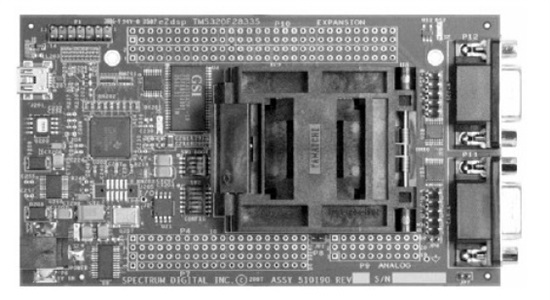Hi!
I'm working with CAN module i make the program on code composer studio and there aren't errors, i connected to transceiver the connector DB9 to twisted pair of lines with the correspondig termination (resistances 120). i don't know how to send the frame messages and how to see them.
Anybody could help me how to probe the CAN network with TMS320F28335?
Thank you
#include "DSP2833x_device.h"
// external function prototypes
extern void InitSysCtrl(void);
extern void InitPieCtrl(void);
extern void InitPieVectTable(void);
extern void InitCpuTimers(void);
extern void InitECan(void);
extern void ConfigCpuTimer(struct CPUTIMER_VARS *, float, float);
void Gpio_select(void);
interrupt void cpu_timer0_isr(void);
void main (void)
{
int counter=0;
struct ECAN_REGS ECanbShadow; //used as a local copy of the original CAN registers
InitSysCtrl(); // Initialize the CPU
EALLOW;
SysCtrlRegs.PCLKCR0.bit.ECANBENCLK = 1; // eCAN-B
EDIS;
EALLOW; // Enable EALLOW protected register access, is possible to write freely in this protected registers
SysCtrlRegs.WDKEY = 0x55;
SysCtrlRegs.WDKEY = 0xAA;
EDIS;
Gpio_select(); // function GPIO30 as TX and GPIO31 as RX
InitECan(); // initialization CAN module
//preparation the transmit mailbox
ECanbMboxes.MBOX5.MSGID.all = 0x10000000; //identifier
ECanbMboxes.MBOX5.MSGID.bit.IDE = 1; //extended identifier
// configure mailbox 5
ECanbShadow.CANMD.all = ECanbRegs.CANMD.all;
ECanbShadow.CANMD.bit.MD5 = 0;
ECanbRegs.CANMD.all = ECanbShadow.CANMD.all;
// enable mailbox #5
ECanbShadow.CANME.all = ECanbRegs.CANME.all;
ECanbShadow.CANME.bit.ME5 = 1;
ECanbRegs.CANME.all = ECanbShadow.CANME.all;
// Data Length Code Field (DLC) in Message Control Register
ECanbMboxes.MBOX5.MSGCTRL.all = 0; //clear all reiaming bits of this register
ECanbMboxes.MBOX5.MSGCTRL.bit.DLC = 1;
ECanbMboxes.MBOX5.MSGID.all = 0x10000000; // message identifier
ECanbMboxes.MBOX5.MSGID.bit.IDE = 1; // Extended Identifier
InitPieCtrl(); // basic setup of PIE table; from DSP2833x_PieCtrl.c
InitPieVectTable(); // default ISR's in PIE
EALLOW;
PieVectTable.TINT0 = &cpu_timer0_isr;
EDIS;
InitCpuTimers(); // basic setup CPU Timer0, 1 and 2
ConfigCpuTimer(&CpuTimer0,150,100000);
PieCtrlRegs.PIEIER1.bit.INTx7 = 1;
IER |=1;
EINT;
ERTM;
CpuTimer0Regs.TCR.bit.TSS = 0; // start timer0
ECanbMboxes.MBOX5.MDL.byte.BYTE0=counter;
ECanbShadow.CANTRS.all=0;
ECanbShadow.CANTRS.bit.TRS5=1; // set the TRS(n) bit to 1 to start the transmission
ECanbShadow.CANTRS.all=ECanbShadow.CANTRS.all;
while(1)
{
while(CpuTimer0.InterruptCount < 10) // wait for 10*100 milliseconds
{
EALLOW;
SysCtrlRegs.WDKEY = 0xAA; // service WD #2
EDIS;
}
CpuTimer0.InterruptCount = 0;
ECanbMboxes.MBOX5.MDL.byte.BYTE0 = counter & 0x00FF ;
ECanbShadow.CANTRS.all = 0;
ECanbShadow.CANTRS.bit.TRS5 = 1; // Set TRS for mailbox under test
ECanbRegs.CANTRS.all = ECanbShadow.CANTRS.all;
while(ECanbRegs.CANTA.bit.TA5 == 0 ) // Wait for TA5 bit to be set.
{
EALLOW;
SysCtrlRegs.WDKEY = 0xAA; // Service watchdog #2
EDIS;
}
ECanbShadow.CANTA.all = 0;
ECanbShadow.CANTA.bit.TA5 = 1; // Clear Transmit Acknowledge #5
ECanbRegs.CANTA.all = ECanbShadow.CANTA.all;
counter++;
GpioDataRegs.GPBTOGGLE.bit.GPIO34 = 1; // toggle red LED LD3 @ 28335CC
}
}
void Gpio_select(void)
{
EALLOW;
GpioCtrlRegs.GPAMUX1.all = 0; // GPIO15 ... GPIO0 = General Puropse I/O
GpioCtrlRegs.GPAMUX2.all = 0; // GPIO31 ... GPIO16 = General Purpose I/O
GpioCtrlRegs.GPAMUX2.bit.GPIO30 = 1; // Enable pull-up for GPIO30 (CANRXA)
GpioCtrlRegs.GPAMUX2.bit.GPIO31 = 1; // Enable pull-up for GPIO31 (CANTXA)
GpioCtrlRegs.GPBMUX1.all = 0; // GPIO47 ... GPIO32 = General Purpose I/O
GpioCtrlRegs.GPBMUX2.all = 0; // GPIO63 ... GPIO48 = General Purpose I/O
GpioCtrlRegs.GPCMUX1.all = 0; // GPIO79 ... GPIO64 = General Purpose I/O
GpioCtrlRegs.GPCMUX2.all = 0; // GPIO87 ... GPIO80 = General Purpose I/O
GpioCtrlRegs.GPADIR.all = 0;
GpioCtrlRegs.GPADIR.bit.GPIO9 = 1; // peripheral explorer: LED LD1 at GPIO9
GpioCtrlRegs.GPADIR.bit.GPIO11 = 1; // peripheral explorer: LED LD2 at GPIO11
GpioCtrlRegs.GPBDIR.all = 0; // GPIO63-32 as inputs
GpioCtrlRegs.GPBDIR.bit.GPIO34 = 1; // peripheral explorer: LED LD3 at GPIO34
GpioCtrlRegs.GPBDIR.bit.GPIO49 = 1; // peripheral explorer: LED LD4 at GPIO49
GpioCtrlRegs.GPCDIR.all = 0; // GPIO87-64 as inputs
EDIS;
}
interrupt void cpu_timer0_isr(void)
{
CpuTimer0.InterruptCount++;
EALLOW;
SysCtrlRegs.WDKEY = 0x55; // service WD #1
EDIS;
PieCtrlRegs.PIEACK.all = PIEACK_GROUP1;
}


